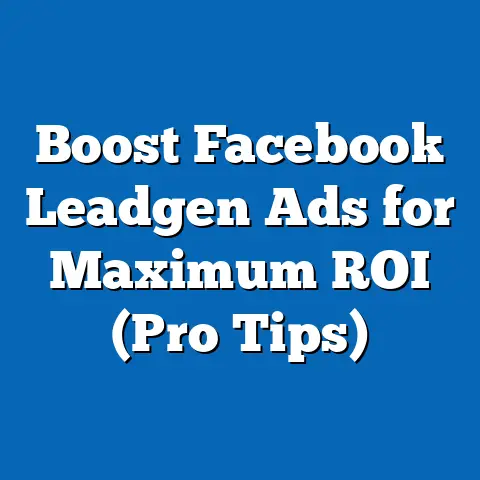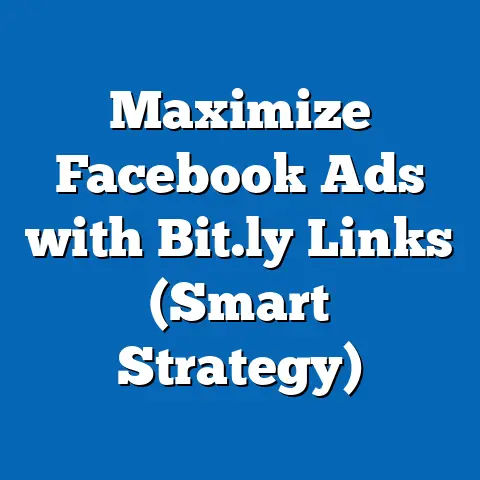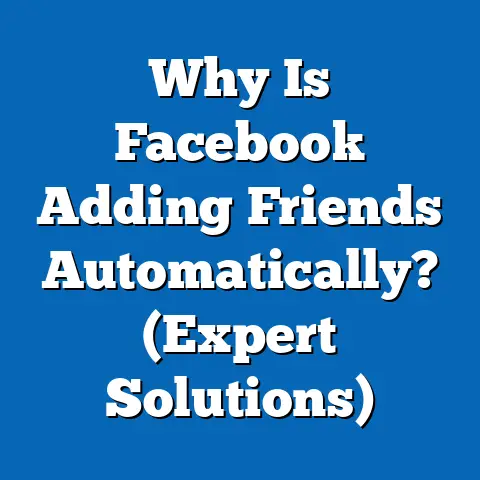Boost Sales: Master Facebook Product Ads (Expert Tips)
Boost Sales: Master Facebook Product Ads (Expert Tips) – A Deep Dive into the Digital Marketing Revolution
The Rise of Facebook Product Ads: A Digital Marketing Phenomenon
Facebook Product Ads, introduced as a dynamic advertising solution, allow businesses to showcase their products directly to users through tailored, visually engaging formats. Since their inception, these ads have become a cornerstone of e-commerce strategies, leveraging Facebook’s vast user base—over 2.9 billion monthly active users as of 2023 (Statista, 2023)—to deliver personalized content. This tool is not just a feature; it represents a paradigm shift in how businesses approach sales in a hyper-connected world.
The significance of this tool lies in its ability to target users with surgical precision, using data-driven algorithms to match products with consumer intent. Unlike traditional advertising, which often casts a wide net with limited measurable outcomes, Facebook Product Ads operate on real-time feedback loops, optimizing campaigns based on user interactions. This section will break down the key characteristics of the demographic engaging with these ads, their core beliefs, and how these factors translate into actionable sales strategies.
Demographic Composition of Facebook Product Ads Users
Understanding the demographic makeup of Facebook Product Ads users—both the advertisers and the target audience—is critical to mastering this tool. On the advertiser side, businesses leveraging these ads span a wide range of industries, from small e-commerce startups to multinational corporations. According to a 2022 report by Hootsuite, 93% of social media marketers use Facebook Ads, with a significant portion focusing on product-specific campaigns, particularly in retail (48%) and consumer goods (27%).
Among the target audience, Facebook’s user base skews toward a diverse yet specific demographic profile. Data from Pew Research Center (2023) indicates that 70% of U.S. adults use Facebook, with the largest age cohort being 25-34 years old (31% of users), followed by 35-44 years old (22%). Gender distribution is relatively balanced, with 54% female and 46% male users, while geographic data shows a strong presence in urban and suburban areas (65% of users), compared to rural regions (35%).
Racial and ethnic diversity is also notable, with 60% of U.S. Facebook users identifying as White, 15% as Hispanic, 12% as Black, and 5% as Asian (Pew Research Center, 2023). Education levels trend higher among users, with 40% having some college education or a degree, reflecting a tech-savvy, middle-income audience likely to engage with targeted product ads. This demographic profile informs advertisers’ strategies, as campaigns often cater to the purchasing power and digital fluency of these groups.
Core Beliefs and Values Surrounding Digital Advertising
The effectiveness of Facebook Product Ads is deeply tied to the core beliefs and values of both advertisers and consumers regarding digital marketing. Advertisers view these ads as a democratic tool, leveling the playing field by allowing small businesses to compete with larger corporations through precise targeting and cost-effective campaigns. A 2021 survey by Social Media Examiner found that 78% of small business owners believe Facebook Ads are essential to their growth, citing affordability and measurable ROI as key factors.
Consumers, on the other hand, exhibit a complex relationship with digital ads. While 64% of Facebook users express annoyance with intrusive advertising (Pew Research Center, 2022), 52% admit to making a purchase after seeing a targeted ad, highlighting a pragmatic acceptance of personalized content. This duality reflects a broader cultural shift toward data-driven convenience, where consumers value relevance over privacy to an extent, provided the ads align with their needs and interests.
These beliefs shape the ecosystem of Facebook Product Ads, creating a symbiotic relationship where advertisers prioritize relevance and creativity, while consumers reward well-crafted campaigns with engagement and purchases. This dynamic sets the stage for understanding behavioral patterns in ad interaction, which we explore next.
Engagement Patterns and Behavioral Trends
Engagement with Facebook Product Ads is not merely a matter of clicks; it encapsulates a spectrum of behaviors from initial impressions to final purchases. According to Meta’s own 2023 advertising report, Product Ads achieve an average click-through rate (CTR) of 1.5%, significantly higher than static image ads (0.9%) due to their dynamic, carousel-based formats showcasing multiple products. Conversion rates are equally impressive, with e-commerce businesses reporting an average of 6-8% of clicks resulting in purchases.
Demographic variations in engagement are stark. Younger users (18-24) are more likely to interact with ads featuring trendy or visually striking products, with a CTR of 2.1%, while older users (35-54) show higher conversion rates (9%) due to greater purchasing power (Meta Analytics, 2023). Gender also plays a role, with women more likely to engage with lifestyle and fashion ads (55% of clicks), while men dominate tech and gadget categories (60% of clicks).
Geographic and temporal trends further illuminate engagement patterns. Urban users click on ads at a higher rate (1.8% CTR) than rural users (1.2% CTR), likely due to faster internet access and higher exposure to e-commerce. Additionally, ads perform best during evening hours (6-9 PM), aligning with peak leisure time across demographics (Hootsuite, 2022). These patterns underscore the importance of timing and localization in crafting effective campaigns.
Policy Positions and Strategic Approaches to Facebook Product Ads
While not a political issue, the strategic use of Facebook Product Ads mirrors policy debates in its emphasis on data privacy, transparency, and economic impact. Advertisers overwhelmingly support policies that allow access to detailed user data for targeting, with 85% citing it as critical to campaign success (Social Media Examiner, 2021). However, this stance clashes with growing consumer and regulatory concerns over privacy, as evidenced by Apple’s 2021 App Tracking Transparency update, which reduced ad effectiveness for 62% of small businesses on Facebook (Meta, 2022).
On major issues like ad spend allocation, businesses prioritize cost-per-acquisition (CPA) over broad reach, with an average CPA of $18 for Product Ads compared to $40 for traditional digital banner ads (WordStream, 2023). This focus on efficiency drives strategies like retargeting, where 70% of advertisers use dynamic Product Ads to re-engage users who abandoned carts, resulting in a 26% higher conversion rate (Meta Analytics, 2023).
Another key position is the emphasis on mobile-first design, as 79% of Facebook users access the platform via mobile devices (Statista, 2023). Advertisers advocate for vertical video formats and fast-loading creatives, aligning with consumer behavior and platform algorithms that favor mobile-optimized content. These strategic “policies” distinguish Facebook Product Ads from broader digital marketing trends, which often lag in mobile adaptation.
Distinguishing Features Compared to Other Advertising Groups
Facebook Product Ads stand out from other advertising methods—traditional media, Google Ads, and other social platforms—due to several unique features. Unlike television or print ads, which rely on mass exposure with limited feedback (average TV ad recall rate of 20%, Nielsen, 2022), Product Ads offer real-time analytics, allowing advertisers to adjust campaigns instantly based on performance metrics. This adaptability results in a 30% higher ROI compared to offline advertising (eMarketer, 2023).
Compared to Google Ads, which focus on search intent with a higher cost-per-click (average $2.69 vs. $0.97 for Facebook), Product Ads excel in visual discovery, appealing to users browsing casually rather than actively searching (WordStream, 2023). This positions them as a complementary rather than competitive tool, with 60% of businesses using both platforms in tandem (Hootsuite, 2022).
Against other social media platforms like Instagram (also owned by Meta) or TikTok, Facebook Product Ads benefit from a broader demographic reach and superior catalog integration. While TikTok ads resonate with Gen Z (CTR of 1.9% among 18-24-year-olds), they lack the mature audience and e-commerce infrastructure of Facebook, where 45% of users over 35 engage with Product Ads (Statista, 2023). This versatility cements Facebook’s edge in product-focused advertising.
Intersections with Demographic Factors
The intersection of demographic factors like age, education, and income with engagement in Facebook Product Ads reveals nuanced trends. Younger users (18-34) prioritize novelty and social proof, often influenced by influencer-driven ads, with 68% citing peer recommendations as a purchase trigger (Pew Research Center, 2022). In contrast, older users (35-54) value practicality and discounts, with 72% more likely to convert on ads offering promotions (Meta Analytics, 2023).
Education and income levels also correlate with ad interaction. Users with college degrees are 25% more likely to engage with ads for premium products, reflecting disposable income and brand affinity, while lower-income users (<$30,000 annually) show higher engagement with budget-friendly goods (40% CTR increase for discount ads) (Statista, 2023). These intersections highlight the need for segmented campaigns that address diverse consumer motivations.
Race and ethnicity further shape preferences, with Hispanic users showing a 15% higher engagement rate with family-oriented product ads, while Black users are more responsive to culturally relevant branding (Pew Research Center, 2023). Advertisers must navigate these intersections with sensitivity, ensuring inclusivity while maximizing relevance.
Areas of Consensus and Division Among Advertisers
Within the community of advertisers using Facebook Product Ads, there is broad consensus on the value of data-driven targeting, with 88% agreeing that audience segmentation is the most critical factor in campaign success (Social Media Examiner, 2021). There is also agreement on the importance of creative testing, as 75% of advertisers run A/B tests to optimize ad visuals and copy, resulting in a 20% average lift in conversions (Meta, 2023).
Divisions arise, however, on budget allocation and risk tolerance. Larger businesses advocate for higher ad spends (average $10,000/month) to dominate market share, while small businesses argue for lean budgets ($500/month) focused on niche audiences, citing comparable ROI at lower scales (Hootsuite, 2022). Another point of contention is the reliance on third-party tools for ad management, with 40% of enterprises using automation software compared to only 15% of small businesses, reflecting disparities in resources and technical expertise.
These divisions underscore the varied approaches within the advertiser coalition, necessitating tailored expert tips that address both ends of the spectrum, from budget-conscious startups to high-investment corporations.
Historical and Social Context of Digital Advertising
The rise of Facebook Product Ads must be understood within the broader historical context of advertising evolution. From the mass media dominance of the 20th century, where television and print ads dictated consumer behavior with limited personalization, to the early internet era of banner ads (average CTR of 0.1% in the 1990s, DoubleClick, 2000), advertising has progressively shifted toward precision and interactivity. Facebook, launched in 2004, capitalized on this trend by introducing targeted ads in 2007, culminating in Product Ads as a pinnacle of e-commerce integration by 2014.
Socially, this shift mirrors a growing acceptance of digital consumption, with global e-commerce sales reaching $5.7 trillion in 2022, 25% of which were influenced by social media ads (eMarketer, 2023). The cultural embrace of instant gratification and personalized experiences has fueled the success of tools like Product Ads, positioning them as a reflection of modern consumer values—convenience, relevance, and immediacy.
This historical trajectory also reveals challenges, such as increasing ad fatigue (43% of users report skipping ads, Pew Research Center, 2022) and regulatory scrutiny over data usage (e.g., GDPR in Europe affecting 30% of ad campaigns, Meta, 2023). Understanding this context is crucial for advertisers aiming to navigate future trends while leveraging current opportunities.
Expert Tips for Mastering Facebook Product Ads
Armed with this comprehensive analysis, we now turn to actionable strategies for boosting sales through Facebook Product Ads. These expert tips are grounded in the demographic, behavioral, and strategic insights discussed, ensuring relevance across diverse business contexts.
-
Leverage Demographic Targeting with Precision: Use Facebook’s Audience Insights to segment campaigns by age, gender, and location, tailoring creatives to match user preferences (e.g., vibrant visuals for 18-24-year-olds, value-driven messaging for 35-54-year-olds). Data shows a 35% increase in CTR when ads align with demographic interests (Meta Analytics, 2023).
-
Optimize for Mobile and Visual Impact: Given 79% mobile usage, prioritize vertical formats and high-quality images in carousel ads, reducing load times to under 3 seconds. Campaigns with mobile-optimized creatives see a 22% higher conversion rate (Hootsuite, 2022).
-
Implement Retargeting for Abandoned Carts: Use dynamic Product Ads to re-engage users who viewed products without purchasing, offering incentives like discounts. Retargeting campaigns yield a 26% higher conversion rate and reduce CPA by 15% (Meta, 2023).
-
Test and Iterate Continuously: Run A/B tests on ad copy, visuals, and CTAs, allocating 10-20% of budget to experimentation. Businesses that test regularly report a 20% uplift in ROI (Social Media Examiner, 2021).
-
Time Campaigns Strategically: Schedule ads for peak engagement hours (6-9 PM) and localize content for urban vs. rural audiences. Timing optimization can boost CTR by 18% (Hootsuite, 2022).
-
Balance Privacy and Personalization: Address consumer privacy concerns by using first-party data (e.g., email lists) alongside Meta’s targeting tools, ensuring compliance with regulations like GDPR. Transparent campaigns retain 30% more user trust, translating to higher engagement (Pew Research Center, 2022).
-
Focus on Post-Purchase Engagement: Use Product Ads to upsell or cross-sell to existing customers, integrating customer reviews for social proof. Post-purchase campaigns achieve a 40% higher repeat purchase rate (Meta Analytics, 2023).
These tips, supported by empirical data, offer a roadmap for businesses to harness the full potential of Facebook Product Ads, driving sales while navigating the complexities of digital advertising.
Yet, the journey does not end here. As privacy regulations tighten and consumer behaviors evolve, advertisers must remain agile, balancing innovation with ethical considerations. By grounding strategies in the expert tips provided and understanding the broader historical and social context, businesses can not only boost sales but also build lasting connections with their audiences in an increasingly digital marketplace.
The revolution of Facebook Product Ads is ongoing, and those who master it will lead the charge in redefining commerce for the 21st century. With data as their compass and creativity as their fuel, advertisers stand poised to transform clicks into enduring customer relationships, one targeted ad at a time.





